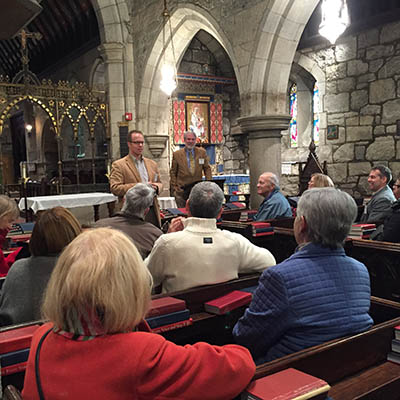 In 2003, Partners for Sacred Places piloted the New Dollars/New Partners training program to teach congregations the skills to restore and steward their historic buildings. The curriculum incorporated best practices in preservation, fundraising, and asset-focused community engagement, all taught by experts in the field. Using this holistic approach, Partners hoped that participants would find “new dollars” and “new partners” in their efforts to maintain not just their buildings, but their valuable community role. Over the past 17 years, over 900 congregations (sponsored by 44 judicatories and other organizations) have participated in New Dollars training. The popularity and success of the program has led to new opportunities for Partners as well as a multitude of churches and synagogues across the country.
In 2003, Partners for Sacred Places piloted the New Dollars/New Partners training program to teach congregations the skills to restore and steward their historic buildings. The curriculum incorporated best practices in preservation, fundraising, and asset-focused community engagement, all taught by experts in the field. Using this holistic approach, Partners hoped that participants would find “new dollars” and “new partners” in their efforts to maintain not just their buildings, but their valuable community role. Over the past 17 years, over 900 congregations (sponsored by 44 judicatories and other organizations) have participated in New Dollars training. The popularity and success of the program has led to new opportunities for Partners as well as a multitude of churches and synagogues across the country.
New Dollars emerged in response to the groundbreaking findings of Partners’ landmark study, Sacred Places at Risk. Published in 1998, the study gained national attention for providing the first research-based approach to documenting the value that historic sacred places provide to their communities. In its conclusion, the report envisioned three new opportunities (among others) that became central to the thinking behind New Dollars:
- helping congregations “tell their stories of … community service and social impact,”
- “promoting models of partnership where congregations attract broader support from government, business and the philanthropic community;” and
- “disseminating best practices” around the care and stewardship of older sacred places.
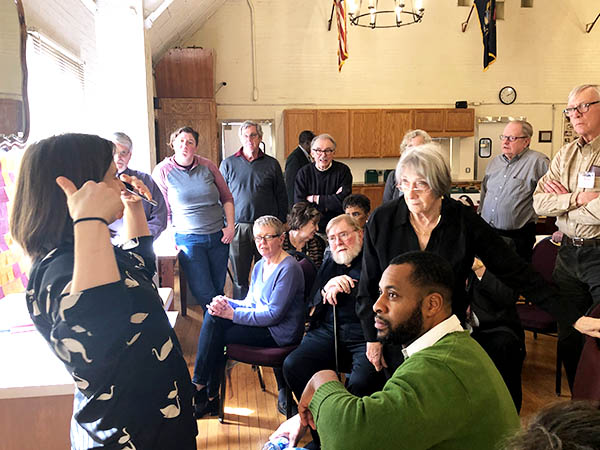
Members of All Saints Episcopal Church in Pontiac, Mich. gather on March 8, 2020 for congregational asset mapping work. Attendees divided into small groups facilitated by members of Partners’ staff, with the group here receiving encouragement and guidance from Sarah Jones, Consulting Services Coordinator.
Photo: Joshua Castaño
Partners decided to develop its own hands-on program to implement some of the recommendations coming out of the Sacred Place at Risk Study. With the leadership of staff member Sarah Peveler and partners from the Asset Based Community Development Institute, Partners created the New Dollars/New Partners training program and its primary resource, the Tool Kit. The program model gathered groups of six to ten congregations in training cohorts that would meet for several days of training, fellowship, and interactive learning over the course of several months. Each session generated concrete next steps and homework for the teams of three to five lay and clergy from each congregation. Training cohorts were typically sponsored by a denominational judicatory such as a presbytery, diocese, or synod, etc. or sometimes a preservation-focused nonprofit organization. The sponsor would help recruit congregations or parishes and assist with general support throughout the program.
To tell the story of New Dollars’ birth and growth, Partners reconnected with some of those who were there at the beginning. These facilitators, conveners, and alumni told us of the immense and immeasurable impact that the training had on them personally, on the participating congregations, and on the congregation’s neighborhoods as they applied the learnings in their communities. Common threads ran through each of these conversations, describing a unique and powerful learning experience.
Sacred Places are Assets, not Liabilities
One of the most important ideas that guides Partners’ work is that sacred places have immense value to their congregations, as well as a larger economic and social value. Unfortunately, the work of maintaining the physical structures can seem to overshadow its worth. Congregations begin to think of the buildings as inescapable burdens that prevent them from serving their members and surrounding community by demanding so much of their energy and finances. One of the most poignant experiences of the New Dollars/New Partners training was a paradigm shift in the thinking of program participants. “Many of these congregations had been thinking about their assets as albatrosses, especially the building,” says The Rev. Michael Mather. “What the whole process of the training seemed to do was help them realize the real value about what they had in hand.”
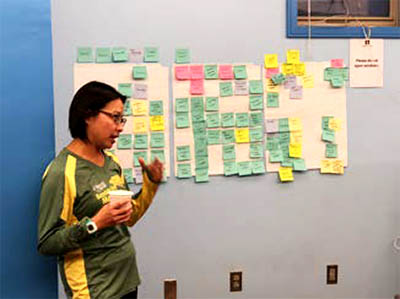
On day two of training, members of University Lutheran in Harvard Square learned about the Asset Based Community Development model and completed a number of asset-mapping exercises to identify the gifts, talents, and resources of their own members and congregation. Here, a member is sharing the ideas her group has created by connecting assets to create new possibilities for growing and strengthening their programming and outreach.
Photo: Joshua Castaño
Mather and several other trainers, including Luther Snow and Mike Green, were among the early facilitators of comes out of Asset Based Community Development, an approach that affirms a community’s strengths and capacities rather than focusing on what it lacks. Mather saw the profound effect that asset-mapping had on congregations and how it helped them engage with their communities. “[Asset mapping] gives people a way to build on what they have instead of what they don’t,” Mather said. “I often heard back from folks at the training that they came in feeling bereft, and they walked away knowing that they weren’t. It gave them a new world and new eyes to see it with.” Instead of focusing on what the congregation may have lacked— endowments, preservation knowledge, sizeable membership—participants were encouraged to inventory all the resources that they had. They found an abundance of assets that could be leveraged and connected to both maximize their service to the community and grow the support needed to maintain their buildings.
“[Asset-Mapping] was the ‘Eureka!’ moment for me,” said The Rev. James Moody, pastor of Quinn Chapel A.M.E. Church in Chicago. “This was a way to articulate what I always knew to be true, but had trouble describing…that opportunity rests in the problems you encounter.” Rev. Moody and his wife, Corliss, participated in the first cohort of New Dollars/New Partners in Chicago. Quinn Chapel, the first African American church established in Chicago, was struggling. The congregation was small, the building in a severe state of disrepair, and the church was in one of the most underserved communities in the city. The asset-mapping activity helped Quinn Chapel see the opportunities in its neighborhood instead of focusing just on its challenges. The congregation began inviting children who lived in nearby subsidized public housing to its annual retreat and picnic in Michigan, during which kids discovered an interest in African drumming. One of Quinn Chapel’s members told Moody that he would be willing to teach the neighborhood kids for free; Quinn Chapel bought a set of djembe drums and a drumming ministry was born. Recalling the abundance that emerged, Corliss Moody said “I can’t remember all of the things we did that came out of asset-mapping—it restored the building, the congregation, and the community all at the same time, and that’s the goal.”
Congregations don’t have to reinvent the wheel
The committees and other groups that oversee the maintenance of a congregation’s building are often made up of volunteers with a variety of professional backgrounds, but very few include an architect or a structural engineer. Furthermore, building preservation and maintenance are not included in the curricula of most seminaries, but clergy are frequently asked to make judgment calls on capital projects. Thus, there was no question in Nancy Finegood’s mind that there was a need to train congregations in the preservation of sacred places. Finegood was serving as director of the Michigan Historic Preservation Network when she met Partners’ founder and President Bob Jaeger at a conference of the National Trust for Historic Preservation.
“There wasn’t a week that went by when my staff and I didn’t hear from a church that needed rehab, or a congregation that was moving to the suburbs and was concerned about the future of their building,” Finegood remembers. Partners had the models and tools to build congregations’ capacities to take care of their buildings, both to maintain the physical structure and to fundraise for needed capital improvements. For Finegood, the training provided a way forward.

As part of a months-long process to engage the community and envision a new future for their landmark building, members of University Lutheran Church in Harvard Square Cambridge, attended New Dollars training. Here a small group, supported by Partners’ president, Bob Jaeger, are building their elevator pitch to share in the Meet the Mayor exercise that opens the training. The activity requires teams to create a short but compelling approach that might grab the attention of a major civic leader and lead to a new relationship.
Photo: Joshua Castaño
New Dollars/New Partners participants learn how to assess their building’s needs, solicit appropriate bids from contractors, oversee the work, and gain a new appreciation for the architectural and cultural value of their space. As the training involved multiple sessions, each a few weeks apart, there was often “homework” to complete between sessions. Some of these assignments asked participating congregations to do a walkthrough of their buildings with specific guidance to assess the condition of the masonry, foundations, doors and windows, and other structural components. This was often the first time congregations had done such a comprehensive evaluation of their building; equipped with this knowledge, they were able to put together capital improvement plans with short- and long-term goals. “It really was Preservation 101,” said Corliss Moody, “and we just got smarter and smarter.” Training sessions always included building tours, and the facilitators saw how the participants’ new knowledge were changing the way they saw their houses of worship. “As they went through the buildings, they would point out architectural facets of the buildings that were unique and exciting, as well as the areas that needed work,” remembered the Rev. David Wangaard, who worked as a senior staff member for the Minneapolis Area Synod of the Evangelical Lutheran Church in America when it sponsored a training.
Another stumbling block that congregations often face is the significant financial resources required to fund capital improvement projects. While many faith communities are adept at fundraising among their members for annual operating and program expenses, a large-scale effort to bankroll building improvements can be overwhelming. New Dollars/New Partners “teaches congregations to think like nonprofits, to think beyond their typical ways of raising money,” says Nancy Finegood. Participants learn the basics for conducting a capital campaign, with methods and tools that are new to many. “One of the biggest takeaways for me was the concept of the pyramid of gifts,” said Rev. Moody. A pyramid of gifts is based on the giving history of a congregation’s members, noting that congregation members with greater wealth can often give higher amounts. “Before that, our approach was seeing if we could get everyone to give $1,000 a piece,” said Rev. Moody. “But we had folks who could replicate the giving of 10 to 20 people. So instead of raising $60,000, we raised $250,000 from the same group.”
Not Going it Alone
The cornerstone idea on which New Dollars/New Partners training was built is that a sacred place matters to more people than the congregation to whom it is entrusted. “It’s not just a place where a congregation worships,” said DeAmon Harges, who facilitated some of the early asset-mapping sessions. “It means so much more to the community.” Harges recalled how a particular church in an early training cohort, inspired by the training, began a storytelling initiative in its community, inviting neighbors to tell the congregation how the church had an impact on their lives. “This work really pushed the envelope and prepared them to use the currency of relationships,” The Rev. David Wangaard, said. Wangaard remembers that congregations had not thought much about the immense value that they bring to their surrounding communities. “That entire notion of a congregation’s ‘public value’….it was all new to me and was so different than what we could usually offer congregations.”
During the training, participants learned how to assess the public value of their buildings and articulate that value to both the congregation and community stakeholders. One of the initial activities of every training is called, “Meet the Mayor,” where participants are asked to give a three-minute “elevator speech” in a role play that enacts a chance encounter with their municipal leader. “Funny thing was,” said Rev. James Moody, “I was actually trying to get a meeting with Mayor Daley at that time.” Soon, Rev. Moody was in the real-life conversation, advocating for the City of Chicago to invest in Quinn Chapel’s restoration project. New Dollars/New Partners enhanced Quinn Chapel’s ability to describe its historical significance and community impact in language that could persuade civic leaders to invest in the project. Confident in its case, Quinn Chapel was able to secure city, state, and federal funding for a multi-million-dollar project—a fundraising goal that, before the training, had seemed an insurmountable obstacle for a small congregation.

Members work in small groups during Asset Mapping at Central Congregational Church in Galesburg, Ill.
Photo: Joshua Castaño
Many of the community-serving programs that congregations house have a measurable impact on their neighborhood’s wellbeing, and that impact is inspiring to organizations and individuals outside of the congregations. However, requesting grants from foundations is normally a daunting prospect for participating congregations. “They’d ask, ‘why would foundations care about us?’” remembered Nancy Finegood. “They care because you have a food bank [or some other community outreach program].” Partners facilitated discussions on how to identify appropriate grants for building projects, and how to leverage a congregation’s community value for external support. Participants learned how to build a convincing “case statement” that highlighted the importance of their facilities to their surrounding community, and the relevance of building improvement projects. “Once we learned how to approach funders with a strong case statement, we started raising more money,” said Corliss Moody, summarizing the lessons learned by Quinn Chapel. “But nobody cares about your building unless your building has an impact on people.”
The Legacy and Future of New Dollars/New Partners
Congregations all across the United States, in every type of community, face the challenges of stewarding large historic buildings. These challenges can dominate conversations about a congregation’s future, as well as the future of religious communities at large. “[New Dollars/New Partners] was definitely different from what is usually offered to congregations,” says Rev. Wangaard. Judicatories and other funding sources tend to rely on grants “that don’t do anything significant, that don’t get at the root of things.” Without the tools and inspiration to turn these challenges into opportunities, congregations can begin to see the buildings as burdens and become focused on their lack of capacity, on what they’ve lost over the years. “There are tremendous dreams and visions; [New Dollars/New Partners] was a way to put congregations on the road to fulfilling them.”
Although Quinn Chapel participated in the New Dollars/New Partners training over fifteen years ago, the congregation still uses what they learned in their building stewardship and community engagement ministries. Rev. James and Corliss Moody have been able to share what they’ve learned with other congregations and see the breadth of possibility that comes with this knowledge. “These tools and models have great flexibility,” said Rev. Moody. “Congregations can figure out what tools can work for them and how to best use them in their context.”
The New Dollars/New Partners training continues to open up new opportunities for Partners to serve congregations. For example, congregations have long asked if Partners could play a hands-on role in helping them plan capital campaigns, prompting Partners to begin its successful Capital Campaign Consulting Services arm. New Dollars’ approach to teaching and supporting congregations also helped to inform and shape the National Fund for Sacred Places, which will be investing over $20 million in 100+ historic sacred places over the course of a decade.
Partners plans to update and retool the New Dollars/New Partners curriculum to strengthen its ability to empower and equip congregations, making it available to congregations that do not have a judicatory sponsorship, and responding to new opportunities and new realities in the current religious landscape. For example, the program is utilizing digital tools and remote learning methods to develop online versions of training resources. Partners remains dedicated to helping congregations see “a new world with new eyes:” helping them to recognize and communicate their value, equipping them with the knowledge to maintain and fund their buildings, and strengthening their community impact.
SIDEBAR:
Using Outdoor Sacred Places in New Ways
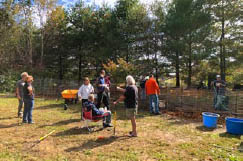 by Cherilyn Widell
by Cherilyn Widell
Director, National Fund for Sacred Places
Historic sacred places often have underutilized indoor spaces available for new uses that can be shared by community partners in urban neighborhoods. Smaller, rural churches, located in corn fields like Shrewsbury Parish on the Eastern Shore of Maryland, have outdoor spaces—like farmland or a cemetery—to offer as well. So, when Shewsbury’s leadership team attended New Dollars training conducted by Partners for Sacred Places, including the asset mapping component, they began to plan how their outdoor areas could connect with their community in new ways.
“It came to the fore through a process we were involved in called ‘New Dollars/New Partners,’ which is a program that churches in the Diocese of Easton partici- pated in to look at how to use historical sites to reach out to the wider community,” The Right Rev. Henry Sabetti said. “In the midst of the whole pandemic, this has been a morale builder,” said Sabetti of the community garden project during the recent planting session in October.
Seed money, literally, came from a $5,000 grant from the Diocese of Easton to explore whether some of the farmland could be used to begin a community garden. The original concept was to share the garden and its bounty with members of the Latinx La Sagrada de Jesus congregation which also worships on the church property. Because Covid 19 had prevented the Latino community from participating, parishioners began building plots and offered them to those in the community who had no land or had never gardened before. The chairman of the Shrewsbury Community Garden, retired farmer Robert O’Connell, reached out to the Bayside HOYAS ( Helping our Youth Achieve Success) which took six plots.
“We were actually looking for a way to teach about nutrition from the ground to the plate, so to speak,” said John Queen, president and co-founder of the HOYAS. “We were just trying to set up the program to implement that part. They’ve been very gracious as hosts,” Queen said, “It’s been great. I’m glad they reached out to the HOYAS and asked us to be a part of it.”
“If we can find enough people,” O’Connell said, “we’ll have room for 15 more plots.” At least 10% of all of the yield is donated to local food banks. “Hopefully next spring we’ll be able to set up hives,” Father Sabetti said. “It’s not just for the parish. It’s for the community. It’s called a ‘community garden’ and we’re going to try to keep it that way,” he said.
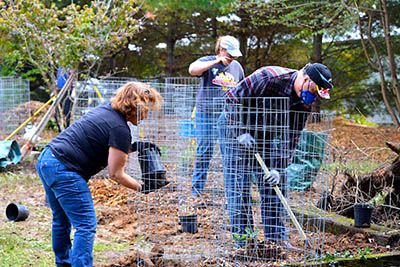
Meanwhile, big things are also happening with new uses in the Old Shrewsbury Cemetery, a cultural landscape which dates to the first quarter of the 18th century. Armed with a grant from Preservation Maryland, Cemetery Warden Robert Busler hired the GIS Laboratory at nearby Washington College to map and interpret each grave and complete a technical survey, including ground penetrating radar, to update the burial records. The nearby Brown House, a 1924 Sears and Roebuck catalogue bungalow once used as the Parish Hall but now empty, will be converted into the Cemetery Office and opened to the public as a Visitor Interpretation Center for the Stories of the Chesapeake Heritage Area.
A large computer screen, with “pop up” capability when a gravesite is selected, will share historical and cultural details about the chosen individual gleaned by college students and genealogists from veteran and local historical society archival records. The existing online web application will incorporate hyperlinks to images for the referenced graves in the cemetery. A future interpretation accessible by Iphone is planned as well.
Additional funds will develop specifications for the rehabilitation of the Brown House as a visitor center that connects to other historic sites in Kent County. Two historic sites that are directly related to the history of the Brown House are the Rosenwald School houses located in the county, built in 1926 and funded by Julius Rosenwald (President of Sears and Roebuck) as part of his African American Schoolhouse philanthropic program.
Despite the pandemic, Shrewsbury Parish has found new dollars, new partners and new uses for its outdoor spaces. Sabetti sums it up: “It’s been fantastic.”
